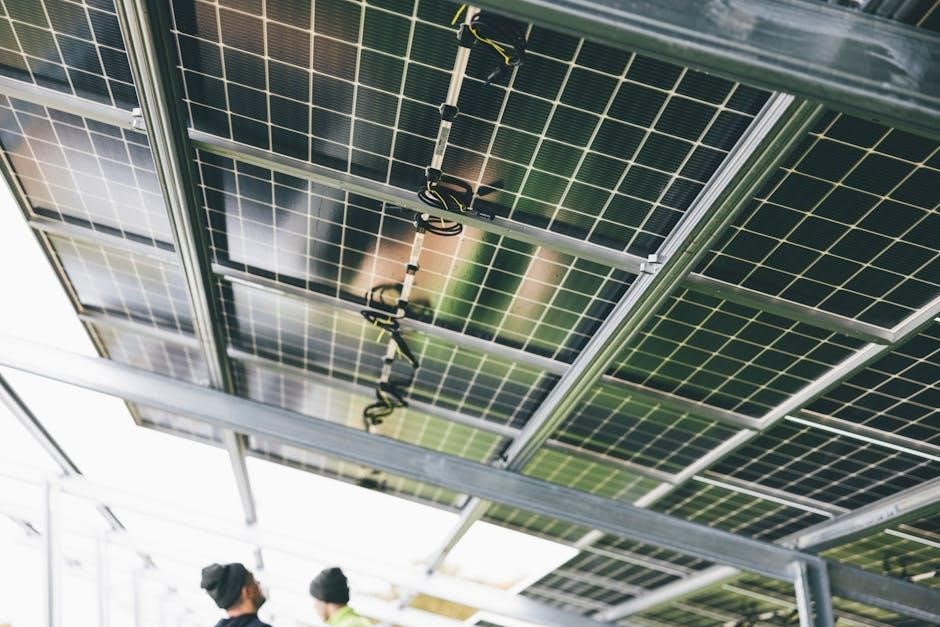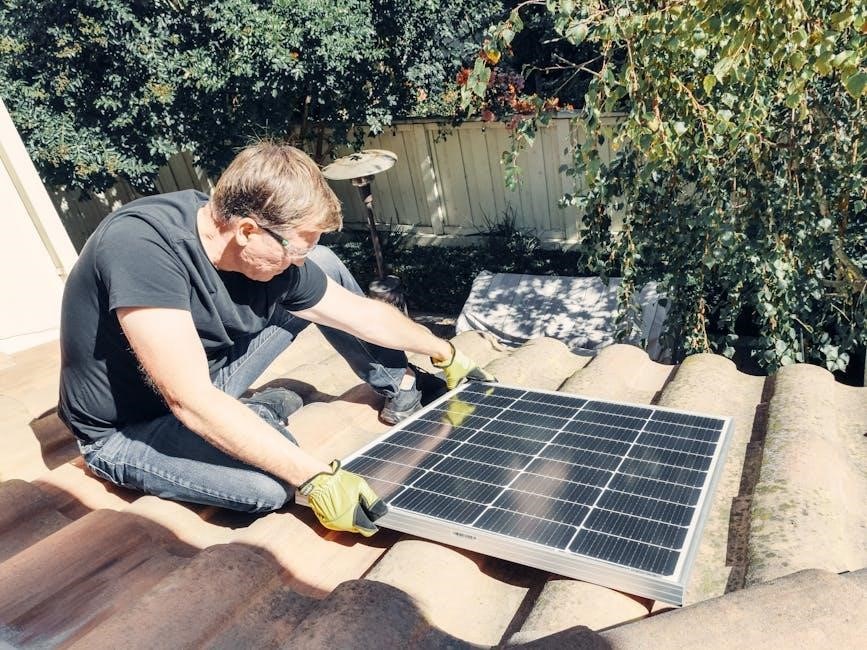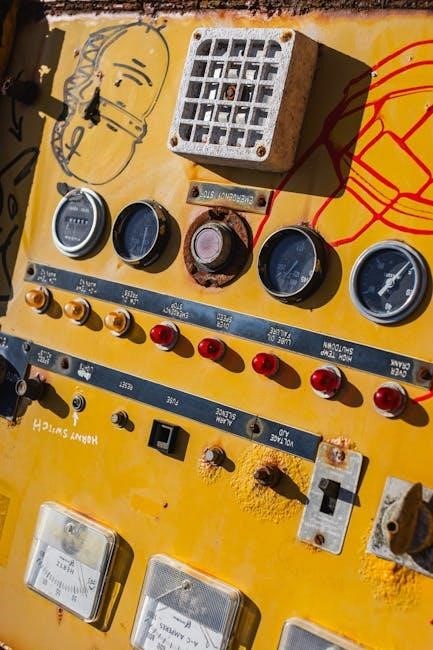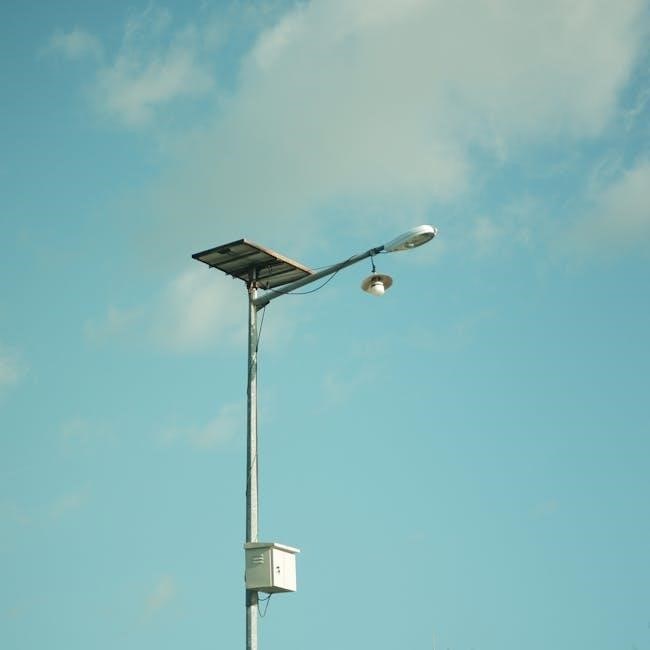
solar panel wiring diagram pdf
A solar panel wiring diagram PDF serves as a comprehensive guide for installing and understanding solar systems, covering residential, RV, and off-grid setups․ It ensures safety, efficiency, and compliance with electrical codes, providing clear schematics for wiring solar panels, inverters, and batteries․ Essential for both beginners and professionals, these diagrams simplify complex connections and troubleshooting, ensuring reliable energy production․ Always refer to manufacturer instructions and local regulations for a secure and optimized solar installation․
1․1 Importance of Solar Panel Wiring Diagrams
Solar panel wiring diagrams are crucial for ensuring safe and efficient installations․ They provide a clear visual representation of connections, preventing errors and potential hazards․ These diagrams help users understand how components like panels, inverters, and batteries interact․ By following a wiring diagram, installers can ensure compliance with electrical codes and manufacturer guidelines․ This reduces risks of system malfunctions and enhances overall performance․ Additionally, diagrams aid in troubleshooting, making it easier to identify and resolve issues quickly․ They are essential for both DIY enthusiasts and professionals, ensuring reliable and secure solar energy systems․
1․2 Purpose of a Solar Panel Wiring Diagram PDF
A solar panel wiring diagram PDF is designed to provide a detailed, step-by-step guide for installing solar systems․ Its primary purpose is to simplify complex wiring processes, ensuring that all components are connected safely and correctly․ The document includes schematics for various setups, such as grid-tied, off-grid, and RV systems․ It helps users avoid common mistakes and ensures compliance with electrical standards․ By following the diagram, individuals can achieve a reliable and efficient solar energy system, whether for residential use or mobile applications․ This resource is invaluable for both novices and experienced installers․

Understanding Solar Panel Wiring Basics
Understanding solar panel wiring basics involves grasping series and parallel connections, voltage and current calculations, and essential safety practices to ensure efficient and secure energy production․
2․1 Series and Parallel Wiring Explained
Series wiring connects solar panels in a chain, increasing voltage while maintaining current․ Parallel wiring connects panels side by side, increasing current while maintaining voltage․ Both configurations optimize energy production, but series setups are ideal for high-voltage systems, while parallel setups suit low-voltage applications․ Proper combination of series and parallel wiring allows for flexible system design, ensuring compatibility with charge controllers and inverters․ Diagrams in a solar panel wiring PDF provide clear visuals for these configurations, simplifying installation and troubleshooting․
2․2 Voltage and Current Calculations in Solar Systems
Voltage and current calculations are critical for designing efficient solar systems․ Series configurations increase voltage, while parallel setups boost current․ Charge controllers and inverters require precise voltage and current matching to function optimally․ Ohm’s Law (V=IR) helps determine system compatibility․ Monitoring voltage limits ensures safety and prevents damage․ Solar panel wiring diagrams provide examples for calculating string configurations and ensuring proper energy flow․ Accurate calculations are essential for maximizing system performance and reliability, especially in off-grid or grid-tied setups․ Always refer to the wiring diagram for specific voltage and current requirements․

Residential Solar Panel Wiring Diagrams
Residential solar wiring diagrams provide clear guides for grid-tied and off-grid systems, ensuring safe and efficient connections for solar panels, inverters, and batteries․ They simplify installations and compliance․
3․1 Grid-Tied Solar System Wiring Schematic
A grid-tied solar system wiring schematic illustrates the connections between solar panels, inverters, and the electrical grid․ It ensures energy flows seamlessly from panels to the inverter, then to the grid․ Key components include solar panels, inverters, circuit breakers, and isolators․ The diagram shows how to connect panels in series or parallel, optimizing voltage and current․ Safety features like rapid shutdown and grounding are highlighted․ Compliance with local electrical codes is essential․ Always follow manufacturer instructions for specific equipment․ Proper wiring ensures efficient energy production and safe grid synchronization, minimizing risks and maximizing system performance․
3․2 Off-Grid Solar System Wiring Diagram
An off-grid solar system wiring diagram details the connections for standalone energy production․ It typically includes solar panels, a charge controller, battery bank, and inverter․ The diagram shows how panels are wired in series or parallel to charge batteries․ Circuit breakers and isolators ensure safety; The inverter converts stored DC power to AC for appliances․ Proper grounding and wire color identification are crucial․ Bluetooth monitoring via apps enables remote system tracking․ Always follow local electrical codes and manufacturer guidelines for a reliable, self-sufficient energy solution, ensuring maximum efficiency and safety in off-grid setups․

RV and Camper Van Solar Wiring Diagrams
RV and camper van solar wiring diagrams provide detailed schematics for portable solar setups․ They cover Anderson plug connections, charge controllers, and inverter installations, ensuring efficient energy management for mobile lifestyles․
4․1 Portable Solar Panel Wiring for RVs
Portable solar panel wiring for RVs simplifies renewable energy on the go․ These systems often use compact panels and plug-and-play connectors, like Anderson plugs, for easy setup․ Key components include a charge controller to regulate power and a battery to store excess energy․ The wiring diagram ensures proper connections between panels, controllers, and batteries, optimizing performance․ Safety features, such as circuit breakers, are essential to prevent overcharging and electrical hazards․ This setup is ideal for campers needing reliable power without grid access, allowing seamless integration into their mobile lifestyle․ Always follow manufacturer guidelines for secure and efficient installation․
4․2 Anderson Plug Wiring for Solar Input
Anderson plugs are widely used for solar input in RVs, offering a reliable and quick connection․ Rated at 50 Amp or 30A, they safely handle high currents from portable solar panels․ The wiring involves connecting the positive and negative leads to the Anderson plug, ensuring proper polarity․ This setup allows easy detachment for mobility while maintaining a secure electrical connection․ Anderson plugs are ideal for camper vans, providing a durable and weather-resistant solution for solar charging․ Always follow wiring guidelines to avoid short circuits and ensure safe, efficient energy transfer to your RV’s battery system․

Components of a Solar Panel Wiring Diagram
Solar panel wiring diagrams include components like solar panels, charge controllers, inverters, batteries, and circuit breakers․ These elements work together to ensure efficient and safe energy production․
5․1 Solar Panels, Charge Controllers, and Inverters
Solar panels, charge controllers, and inverters are essential components in a solar wiring diagram․ Solar panels generate DC power, which is regulated by charge controllers to prevent battery overcharging․ Inverters convert DC power to AC for household use․ Proper wiring ensures optimal energy flow and safety․ These components are interconnected in the diagram, providing a clear visual guide for installation and troubleshooting․ Their correct configuration is vital for system efficiency and longevity․
5․2 Batteries and Circuit Breakers in Solar Systems
Batteries store excess energy generated by solar panels for later use, while circuit breakers protect the system from overcurrent․ In a wiring diagram, batteries are typically connected to the charge controller and inverter, ensuring energy flows safely․ Circuit breakers are installed between components to prevent damage from power surges or short circuits․ Proper wiring of these elements is crucial for system reliability and safety, especially in off-grid setups․ They are often represented in diagrams with clear symbols and connections, simplifying installation and troubleshooting processes․

Safety Precautions and Tools Needed
Essential tools include multimeters, wire cutters, and screwdrivers․ Safety precautions involve using isolators, protective gear, and ensuring all connections are de-energized before work begins to prevent accidents․
6․1 Isolators and Disconnects for Safe Wiring
Isolators and disconnects are critical for safely managing solar panel wiring․ They allow the system to be de-energized during maintenance or emergencies, preventing high DC voltage risks․ Install isolators between solar panels and inverters to ensure safe disconnection; Always use circuit breakers or disconnect switches rated for DC currents․ Proper labeling and grounding are essential to avoid accidental energization․ Follow manufacturer instructions for installation and testing to ensure compliance with safety standards․ Regular inspections of isolators and disconnects are vital for maintaining system reliability and user protection․
6․2 Wire Colors and Grounding Connections
Understanding wire colors and grounding connections is vital for safe solar panel wiring․ Typically, red indicates positive, black negative, and green or bare copper for grounding․ Ensure all connections are secure and properly labeled to avoid confusion․ Grounding solar panels and components prevents electrical shocks and system damage․ Use appropriate grounding rods and connectors to maintain a safe earth connection․ Always follow local electrical codes and manufacturer guidelines for wiring colors and grounding practices to ensure compliance and reliability in your solar system installation․

Troubleshooting Common Wiring Issues
Identify high DC voltage in circuits and ensure proper connections to avoid system damage․ Check isolators and voltage limits in strings for optimal performance and safety․
7․1 Identifying High DC Voltage in the Circuit
High DC voltage in solar circuits can pose significant risks, including equipment damage and safety hazards․ During daylight, panels generate high voltage, requiring isolators to remain open during wiring․ Always check voltage limits in strings to avoid exceeding charge controller specifications․ Use a multimeter to verify voltage levels, ensuring compliance with manufacturer guidelines․ Proper grounding and disconnects are crucial for safe troubleshooting․ Refer to the wiring diagram for precise connections and follow safety protocols to prevent electrical shocks or system malfunctions․ Regular inspections and maintenance are essential for optimal performance and longevity․
7․2 Checking for Proper Voltage Limits in Strings
Ensuring proper voltage limits in solar panel strings is crucial for system efficiency and safety․ Use a multimeter to measure voltage at connectors, verifying it matches the charge controller’s specifications․ Excessive voltage can damage equipment, while low voltage reduces performance․ Balance string configurations to maintain optimal output․ Refer to the wiring diagram for correct connections and follow manufacturer guidelines․ Regular checks prevent voltage fluctuations and ensure compliance with safety standards․ Proper voltage management extends system lifespan and maintains reliable energy production, avoiding potential hazards and ensuring optimal functionality․ Always prioritize accurate measurements and adherence to specified limits․

Compliance with Local Electrical Codes
Ensure your solar system meets local electrical codes by using approved equipment and following installation guidelines․ Refer to the wiring diagram for code-compliant connections and safety standards․
8․1 PV System Equipment and Rapid Shutdown
Ensure all PV system equipment meets local electrical codes and includes rapid shutdown features for safety․ The wiring diagram PDF outlines proper connections for inverters, disconnects, and isolators․ These components must comply with regulations to ensure safe operation and maintenance․ Rapid shutdown mechanisms are critical for emergency situations, disabling power output while maintaining energy flow for safety personnel․ Always verify equipment certifications and follow local guidelines to avoid violations; The diagram provides a clear reference for installing and testing these essential safety features in solar panel systems․
8․2 Manufacturer Instructions for Installation
Always follow the manufacturer’s instructions for installing solar panel systems, as outlined in the wiring diagram PDF․ Each component, such as inverters and charge controllers, may have specific installation requirements․ Adhere to the provided guidelines for wiring, mounting, and configuring equipment to ensure safety and optimal performance․ The diagram serves as a visual reference, but detailed instructions from the manufacturer are crucial for compliance and functionality․ Proper installation ensures system reliability, efficiency, and adherence to safety standards, minimizing risks and ensuring long-term energy production․